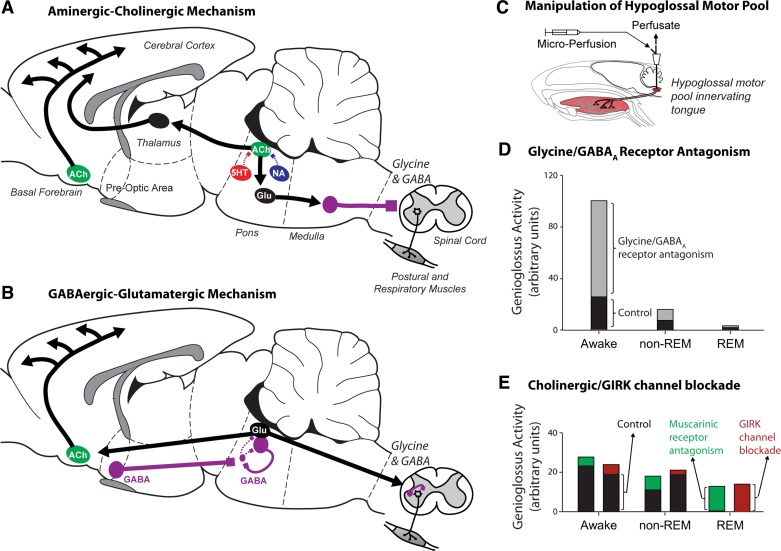Fig. 1.
The rapid eye movement (REM) sleep-generating neuronal machinery according to the aminergic-cholinergic (A) and GABAergic-glutamatergic (B) explanations. Note that, in both explanations of REM sleep generation, descending inhibitory pathways involving glycine (predominantly) and γ-aminobutyric acid (GABA) cause suppression of spinal motor activity. Experimental manipulations of the hypoglossal motor pool (C), however, show that blockade of glycine and/or GABAA receptors activate genioglossus activity across all sleep-wake states, but least of all in REM sleep [D; replotted from original data (71)]. Note the initial level of genioglossus activity with artificial cerebrospinal fluid at the hypoglossal motor pool (i.e., baseline control condition), with progressive decreases in activity from wakefulness to non-REM and REM sleep. Note also the consistent increase in genioglossal activity across sleep-wake states with glycine and GABAA receptor antagonism. This pattern of response is in keeping with release of a tonic, state-independent inhibitory tone. A similar pattern of response has been observed in other studies, including at the trigeminal motor pool (10, 11, 70). The pattern of response with muscarinic receptor and G protein-coupled inwardly rectifying potassium (GIRK) channel blockade is also shown [E; replotted from original data (37)]. This pattern is consistent with blockade of a REM sleep inhibitory pathway. In the anatomical drawings from rodent brain, the solid lines indicate active neuronal groups and projections, respectively, whereas dashed lines indicate suppressed activity. Arrows indicates excitatory projections, whereas solid squares with solid lines indicate inhibitory projections. The relative position and sizes of neuronal groups are shown for visual clarity and are not meant to represent their strict anatomical positions. See text for further details. ACh, acetylcholine; 5HT, 5-hydroxytryptamine (serotonin); Glu, glutamate; NA, noradrenaline. This is an original figure modified and adapted from several sources (43, 44).

